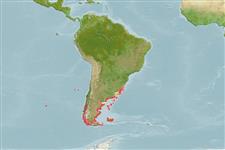Common names from other countries
Classification / Names / Names
Nomes comuns | Sinónimos | Catalog of Fishes (gen., sp.) | ITIS | CoL | WoRMS
Environment: milieu / climate zone / depth range / distribution range
Ecologia
. Temperate; 32°S - 55°S, 74°E - 52°E (Ref. 83435)
Southeast Pacific, Southwest Atlantic and Antarctic Indian Ocean.
Length at first maturity / Tamanho / Peso / Idade
Maturity: Lm ? range ? - ? cm Max length : 2.4 cm DL macho/indeterminado; (Ref. 83435); Idade máx. registada: 5 anos (Ref. 8702)
It is found in intertidal areas of rocky coasts in rock crevices, artificial substrates, on barnacles or mussels (Ref. 87801). It is also found in forests of Macrocystis pyrifera (Ref. 92889).
Life cycle and mating behavior
Maturidade | Reprodução | Desova | Ovos | Fecundidade | Larvas
Egg masses are composed of numerous ovate egg capsules each containing a single embryo that develops within and emerges as a veliger larva. Indirect development.
Rosenberg, G. 2009. (Ref. 83435)
Categoria na Lista Vermelha da IUCN (Ref. 130435)
Categoria CITES (Ref. 108899)
Not Evaluated
Not Evaluated
Utilização humana
| FishSource |
Ferramentas
Fontes da internet
Estimates based on models
Preferred temperature
(Ref.
115969): 7.1 - 14.2, mean 9.5 (based on 269 cells).
Categoria de preço
Unknown.
